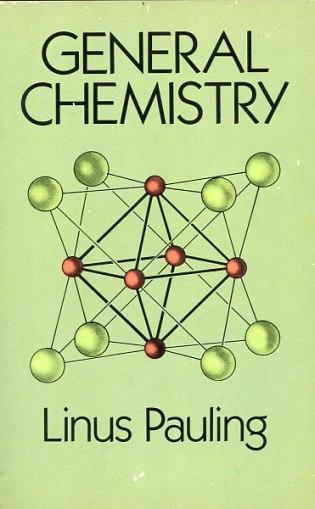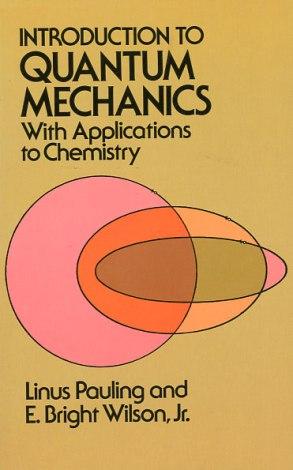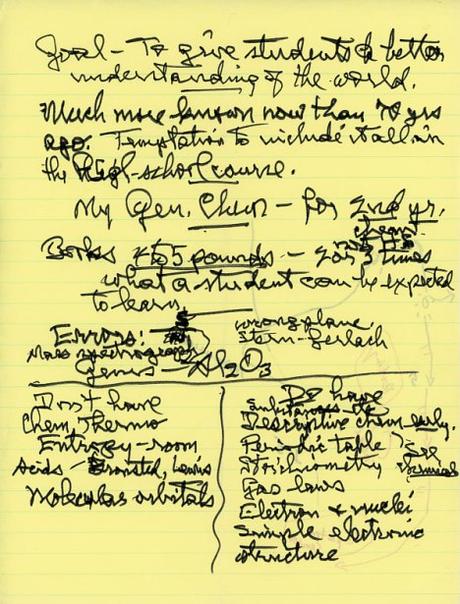
Front cover of the Dover reprint edition of General Chemistry, 1988.
[Our seventh and final post examining the history of Linus Pauling’s textbook, General Chemistry, first published in 1947. This is also our last post for 2017. Many thanks to you, our readers, for another great year! Look for us again in early January.]
In 1979, Linus Pauling contacted his publisher, W.H. Freeman & Co., with the intent to order more copies of the third edition of his General Chemistry text, only to learn that it had gone out of print. Freeman’s new president, Richard Warrington, apologized to Pauling for the lapse in communication, and then noted that the firm had stopped printing the book the previous summer. Warrington explained that sales for 1978 were not sufficient to justify further printing runs of the book: just 387 copies had been sold that year, as compared to 13,469 copies purchased when the third edition went live in 1970. With the book now officially out of print, all rights to General Chemistry reverted back to Pauling and it was up to him to figure out what to do with the content, if anything at all.
Not long after, in 1980, Freeman & Co. came under new management, which promptly ushered in a series of sweeping changes. Now led by Neil Patterson, the firm chose to cease all promotion of back-listed books and allowed dozens of titles to go out of print. Freeman & Co. had merged with Scientific American in 1962 and now shared a CEO with their corporate partner. Because of these connections, Patterson also chose to move the company from San Francisco – the only home that it had ever known – to New York. This relocation led to the diminishment or outright severing of ties with several authors based on the west coast.
Pauling expressed regret that the company had chosen to move across the country, but it was his recent experience with Freeman & Co. – specifically their neglect in communicating to him that one of his signature titles was no longer being produced – that led him to cut ties with the company.
In the midst of all this, Freeman continued to navigate seas of change. Linda Chaput took over as president and executive editor shortly following the move to New York, but the company continued to flail financially. It eventually became an imprint of MacMillan – ironically, the firm at which founder William H. Freeman got his start – but was allowed to keep its name and to market the story of its propitious beginning.

Cover of the Dover reprint of Introduction to Quantum Mechanics, 1985.
Meanwhile, time moved forward and General Chemistry remained out of print, a fact that gnawed on its author. In 1984, Pauling approached New York-based Dover Publications, Inc. to see if they might be interested in resuscitating the third edition. Pauling had reason to believe that this entreaty might be looked upon favorably, as the company had already agreed to release a reprint version of Pauling’s influential Introduction to Quantum Mechanics with Applications to Chemistry, originally co-authored with E. Bright Wilson in 1938.
The Dover edition of Introduction to Quantum Mechanics appeared in 1985 and, as it turned out, sales were promising enough that the firm quickly agreed to sponsor the General Chemistry reprint, offering Pauling a flat sum of $2,000 in place of any royalties. This reproduction made it to market in 1988 and is still available for purchase today.

Pauling’s notes for his talk, “Improving Science Education: Changes That Make it Possible,” January 30, 1984. In particular, Pauling emphasizes the sheer physical size of modern science textbooks, a consistent pet peeve of his.
While the paperback Dover reprint keeps General Chemistry alive today, it is the Freeman editions that stand as true classics. General Chemistry was sold by the firm for thirty-one years, an extraordinarily long life for a college science textbook. And for the bulk of those three decades, the title served as the flagship for Freeman & Co.’s chemistry series, while also providing inspiration, if not a template, for similar series written for other scientific disciplines. Feedback to the book also inspired Pauling to write College Chemistry, a slightly more traditional text which likewise went through three editions and remained very popular with chemistry teachers at the high school and college levels for decades.
General Chemistry and later College Chemistry reflected a change of style in textbook writing that sought to thread a small needle. Essentially, Pauling took it upon himself to challenge engaged students while also making scientific concepts more accessible. He did so by organizing and reimagining content in radically different ways. Pauling was, for example, the first author of a chemistry textbook to use chemical bonding and molecular structure as guiding pedagogical principles. His was also the first textbook to explain elements, isotopes, and compounds in terms of electron shells and atomic weight, an approach that has since become the norm.
General Chemistry was hugely important in at least one other way. Though Pauling had set out to write a textbook oriented primarily toward students of chemistry, the book initiated and propelled a much larger conversation among his colleagues, particularly those seeking to author their own volumes. Within a decade of Pauling publishing General Chemistry, introductory chemistry texts around the world had begun following the contours of Pauling’s model, emphasizing physical and descriptive chemistry as well as real-world applications of chemistry and the scientific method.
And even after he had moved on from devoting significant time or attention to the textbook game, Pauling strove to ensure that his revolutionary work would continue. At a 1984 meeting of the Oregon Consortium for Quality Science Education, for example, he urged textbook authors to work harder to make their material more engaging and accessible to students. Worried that many high school textbook writers suffered from a superficial knowledge of their subjects, Pauling warned that these authors risked discouraging otherwise successful students from becoming scientists by leading them to believe that they could not grasp fundamental topics. In issuing this warning, Pauling was also distilling a core belief of his own: a well-written textbook can influence student success at least as much as the initiative put forth by a teacher in the classroom.
Advertisements &b; &b;